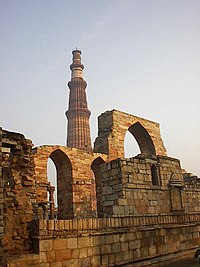Qutb Minar


Qutub Minar (Urdu: قطب منار)is the tallest brick minaret in the world, and an important example of Islamic architecture. The tower is in the Qutb complex at Delhi, India. The Qutub Minar is 72.5 metres high and visitors must climb 379 steps to get to the top. The diameter of the base is 14.3 metres wide while the top floor measures 2.7 metres in diameter. It is listed as a UNESCO World Heritage Site.
Inspired by the Minaret of Jam in Afghanistan and wishing to surpass it, Qutb-ud-din Aybak, the first Muslim ruler of Delhi, commenced construction of the Qutub Minar in 1193; but could only complete its basement. His successor, Iltutmish, added three more stories and, in 1368, Firuz Shah Tughluq constructed the fifth and the last story. The development of architectural styles from Aybak to Tughluq are quite evident in the minaret. Like earlier towers erected by the Ghaznavids and Ghurids in today's Afghanistan, the Qutub Minar comprises several superposed flanged and cylindrical shafts, separated by balconies carried on Muqarnas corbels. The minaret is made of fluted red sandstone covered with intricate carvings and verses from the Qur'an, and is built on the ruins of Lal Kot, the Red Citadel in the city of Dhillika. According to John Keay's "History of India," 27 previous Hindu and Jain temples were destroyed and their materials reused to construct the minar.

The purpose for building this beautiful monument has been speculated upon, apart from the usual role of a minaret - that of calling people for prayer in a mosque- in this case the Quwwat-ul-Islam mosque to the northeast of minar in AD 1198. It is the earliest extant -mosque built by the Delhi Sultans.Other reasons ascribed to its construction are as a tower of victory, a monument signifying the might of Islam, or a watch tower for defence. Controversy also surrounds the origins for the name of the tower. Many historians believe that the Qutub Minar was named after the first Turkish sultan, Qutb-ud-din Aibak but others contend that it was named in honour of Khwaja Qutb-ud-din Bakhtiar Kaki, a saint from Baghdad who came to live in India who was greatly venerated by Iltutmish. According to the inscriptions on its surface it was repaired by Firuz Shah Tughlaq (AD 1351-88) and Sikandar Lodi (AD 1489-1517). Major R.Smith also repaired and restored the minar in 1829
For information on other notable structures in the Qutb complex, see the main article.
External links
